American fighter McDonnell XF-85 Goblin
The first thoughts were to create a strategic bomber that could, having taken off from the territory of the United States, overcome a considerable distance to the enemy’s positions, and, after completing a combat mission, return, the American military appeared back in 1941. The reasons for the appearance of these thoughts were the first defeats in the Pacific War, as well as the likelihood that Britain would fall. So the technical task for the aircraft appeared six-engine strategic bomber B-36. The development of the machine was delayed so much that in the war she did not have time to take part. When the construction of the aircraft with a range of about 9 thousand km was coming to an end, it turned out that it did not fit into the concept of using bomber aviationadopted at that time: there was no escort fighter capable of following the bomber throughout the flight. Already existing aircraft, as well as those that could have been designed to accompany the Convair B-36 with simultaneous launch, did not fit: existing ones - due to insufficient flight range, the projected ones - would turn out to be very heavy and unable to effectively reflect attack interceptors. In addition, the pilot of the escort fighter, being in constant tension throughout the flight, is very tired by the time it becomes necessary to conduct an air battle. Representatives of the US Air Force felt that these problems can only be solved with a non-standard approach.
The US Air Force in December 1942 announced a competition under the designation “Project MX-472” - an escort of a heavy ultra-long bomber. Within two years, a special commission considered a number of projects, but the choice was made on a fighter project of the so-called “parasitic” type, which most of the flight would have been inside the bomber and, if necessary, released outside. This decision was not absolutely new - long before Convair B-36 there existed airships of a similar pattern.
The only company that presented a fairly seriously developed project of a fighter of this type was the newly created McDonnell. Despite the problems that had arisen, the engineers of the company under the leadership of Barkley, who had previously worked for the firm Curtiss, in a short time presented several projects that met the requirements put forward by the Air Force. The options offered differed in the type of attachment: internal or semi-submerged suspension. Representatives of the US Air Force to the beginning of 1945, chose the project, which provided for an internal suspension. In the company, the car received the designation “Model 27D”.
An order for the development of prototypes (designation of the XF-85 military) from the US Air Force arrived in March 1947, and the first independent flight took place on 23 in August of the following year. The fighter was launched from a Boeing EB-29В bomber. Flight tests showed that serious control problems created turbulence around the bomber. Coupled with the fact that such a miniature aircraft could not have the maneuverability and speed of the fighters with which it was to encounter in the air, this led to the termination of development.
The dimensions of the bomber’s carrier bomb bay (4,88 x 3,0 m) were limited by the dimensions of the XF-85 itself. The length of the fuselage - 4,32 m (full length of the aircraft - 4,5 m) width 1,27 m, height 2,0 m. The aircraft was equipped with four large-caliber machine guns. According to the specification, a fighter at an altitude of 10-12 thousands of meters could be released and taken within a minute and a half. The fuselage is an all-metal semi-monocoque made of aluminum alloys. Equipment, fuel tanks and weapons were installed inside the fuselage, since the wing was thin, had a folding unit and a complicated structure at the root. Wingspan 6,44 m, sweep on the leading edge 37 degrees. The aircraft had no landing gear - only auxiliary runners designed for an emergency landing. Tail plumage - six-plane.
The XF-85 Goblin cab had a volume of 0,74 m3. Despite such small dimensions, heating, pressurization and pressurization were provided for in the cabin. In addition, the designers managed to "squeeze" the high-pressure oxygen supply system, as well as the oxygen balloon for the pilot's breathing after the emergency escape of the aircraft (this was necessary because the practical ceiling was 15 thousand meters). The pilot rescue system was a T-4E ejection seat with a backrest angle of 33. The tightness of the cabin led to the fact that the height-adjustable machine gun sight and pedals, and not the chair. In addition, the selection of pilots for this aircraft was also caused by small dimensions: no more than 172 cm height, weight (together with a suit) - up to 90 kg.
The fuel system consisted of a single 435 liter protected horseshoe-shaped fuel tank encircling the engine. This volume at full engine power was provided by 20 flight minutes, in cruising mode - 32 minutes. During the tests, the flight duration was reached 1 hour 17 minutes. It was assumed that the serial aircraft in the gargrote will be installed 95-liter tank and two wing-compartment tank capacity of 113 liters. All tanks were equipped with an inert gas filling system. In addition, the aircraft was supplied with carbon dioxide fire extinguishing system.
In the nose of the fuselage was installed turbojet Westinghouse J34-WE-7 (thrust 1361 kg). This location was chosen to move the fighter's center of gravity forward. Due to this, the tail tail has increased. By the cut of the nozzle from the engine there was a 1320-mm exhaust pipe; the pipe and engine were covered with a layer of fiberglass wool and aluminum foil to reduce heat transfer. In addition, the air coming in from the air intake blew the engine outside. If the flow velocity exceeded the 250 km / h, the engine turbine was autorotized, which made it possible to exclude scrolling of the turbocharger when starting from the aircraft carrier. Battery Willard VV 206 / V served as ignition.
In the course of the design, we considered several variants of the fighter's support, including the use of a long cable having a loop at the end. The fighter after the capture of which was drawn into the bomb bay. However, due to the non-rigidity of the cable, there was a probability of collision between the carrier and the retractable fighter. In order to avoid such situations, a rigid trapezoid of a complex construction, which took the parasitic fighter away from the carrier's fuselage, was chosen as a device for the attachment, nullifying the risk of a collision.
The attachment device, which was mounted on the fighter - a retractable steel hook equipped with a spring-loaded safety bracket. To detach from the carrier, the head of the hook was rotated. Cleaning drive - electric. The suspension system was designed on the basis of a similar device previously used on Mekon and Acron airships. The head of the hook in the released position was in the field of view of the pilot over the front of the lamp.
Cab congestion is also reflected in the configuration of the dashboard. It installed the necessary minimum of instruments: navigation - gyrocompass and automatic radio compass (ARC) indicators; aerobatic - airspeed pointer, accelerometer and altimeter; engine control devices - indicators of turbine temperature, turbocharger speed, fuel pressure and fuel gauge. There was also a cabin pressure gauge. In order for the pilot in the ejection did not hurt his legs, the instrument panel was shot along with the cockpit lantern. The radio equipment of the serial “stray” fighter was to consist of the AN / ARC-5 VHF radio station and the AN / APN-61 radio compass. Antenna radio stations planned to be placed in the tip of the upper left keel. There was no radio equipment on the prototypes.
Aircraft wiring to ensure fire safety was removed in fireproof boxes and sleeves. There were connectors in the side of the air intake and in the suspension hook for connecting external power supply.
The roll control system did not have boosters. Aileron normal type, with adjustable trimmers in flight and aerodynamic compensation. The control over the pitch channel, in contrast, was organized in a very peculiar way - due to the differential deviation of the four steering surfaces located crosswise. The principle of deviation of the steering surfaces was based on the same principle as for airplanes with V-shaped tails: when pedaling, they deviated in different directions, and when giving the handle - in one direction. The original differentiating mechanism was installed in the control channel of the tail surfaces. Handlebars are also supplied with adjustable trimmers in flight. The adjustment was particularly important, as the centering of the fighter changed dramatically as the fuel developed.
Armament XF-85 Goblin consisted of four 12,7-mm lightweight machine guns "Colt-Browning" M-3. Ammunition - 300 ammunition on the barrel. On prototypes embrasures weapons closed with overlays. The installation of a cinema-photo-gun was also envisaged. It was planned that the machine guns would later be replaced by Ford-Pontiac M-39 cannons of 20 caliber of millimeters. The weapon was reloaded with the help of a pneumatic system, the air for which was taken from the engine compressor.
Before the start of flight tests, due to the obviously small shoulder and insufficient vertical tail area, both prototypes were fitted with a pair of additional fixed keels — below and above the tail cone. This solution allowed to increase the road stability. Under the fuselage there was an aerodynamic brake made in the form of a hydraulically deflected flap. The control was carried out by a slider located on the ORD. When speeding in 900 km / h, the flap automatically deflected. When speed drops below 297 km / h, automatic slats were deflected. Drive - through a worm pair, electromechanical.
At the request of the air force representative, primitive landing gears were installed on the aircraft, which, when landing on the ground, were supposed to prevent damage. They were a highly spring-forward ski-spring, bent out of a steel strip, and two small steel heels mounted on the ends of the wing.
2 June 1946 of the year the wooden mock-up of the fighter and the hanging trapeze for it were demonstrated to the customer’s representatives. June 8 air force for static tests ordered 2 prototype aircraft and a glider. All of them did not have electronic equipment and weapons. At the end of 1946, the first prototype of the Goblin, built with great care and as soon as possible, was delivered from the McDonnell pilot plant (St. Louis, Missouri) to Moffett Field (California) airbase for purging in a NASA wind tunnel . However, during transportation, the prototype suffered a big failure - when loading onto the trailer due to poor stitching, the airplane broke down and fell onto the concrete from a three-meter height. The fall damaged the nose, engine and fuel tank. The first Goblin was returned to St. Louis for renovation. The tests continued on the second prototype.
The Mc-Donnell outboard fighter program aroused so much interest among the customer’s representatives that Konver was instructed to equip all B-36 production bomber (starting with 23 vehicles) with a trapeze for Goblin. In addition, 10% of these bombers were to be produced in the form of "clean" air carrier capable of carrying three or four "parasitic" fighter. The first Goblin series was to consist of 100 machines. In addition, there was a project of its conversion to a portable reconnaissance aircraft (it was embodied in the FICON system, the Replay F-84F Replay, based on the GRB-36 carrier). Purges were completed at the start of 1948. According to their results, it became clear that the slats are ineffective, and in the released state, the hook lowers track stability by 75%. This was due to the fact that the open well for cleaning the hook at high speed acts as a plate set across the stream. The angle of deviation of the slats was increased, the hook was fixed in the released position, the hook well was closed with a fairing. After the modifications, the car was delivered to Myurok Dry-Lake Air Base. There, it was already awaited by the EB-29 bomber, bearing its own name "Monster", converted into a carrier.
This aircraft was in service, but did not participate in hostilities. By the time it was reworked for XF-85 media, it had flown 180 hours. The main alterations were the expansion of the rear bomb bay and the installation of the folding trapezoid of the McDonnell company. In addition to the loop-suspension, this design had a lifting yoke, which, in the lowered state, covered the Goblin's nose piece, preventing it from swaying. Trapeze in the released position went down on the 3,2 meter. A sealed trapezoid control post was also equipped in the rear bomb bay, and the waiting room near it was the place where the Goblin pilot waited for the signal.
The operator during uncoupling-holding got in touch with the XF-85 “Goblin” pilot with the help of a low-power VHF radio. For filming and photographing the process of releasing and receiving the Goblin on board, film and cameras were installed on the lower surface of the carrier's wing. The tail end of the “Monstro” was painted in bright yellow color to increase visibility, wide yellow and black stripes were placed on the bottom and bottom. So that during takeoff the fighter, hanging under the tail bomb bay in a semi-submerged position, does not accidentally touch the surface of the runway, the Monstro tail support is extended. Since the clearance of the former bomber was inadequate loading "Goblin" carried out through the pit. First, the fighter was driven into the pit on the trolley, then the carrier drove over it from the top, lowered the trapezium and carried out a hook. The only test pilot involved in the Goblin's test program was Edwin Skosh, Mac-Donnell's chief pilot, a former US Navy pilot.
In early June, 1948 conducted the first flights of the Monstro with GoFlin XF-85 on board. Ed Skosh, after the first ascent, insisted on carrying out uncoupling and independent flight, he literally fell in love with the new fighter, and it looks like the plane responded to it in return; None of the many abnormal situations that occurred during the tests ended tragically. During the first flights, the Goblin engine was tested and tested. In addition, they developed a preflight procedure: first, the Goblin went down on a trapeze, the pilot had to exit the sealed “waiting room” through the airlock, along an unencumbered, narrow metal path, go to the fighter’s cabin, which was again pulled into the compartment, climb inside without any stepladder, close the lamp and only after that but was in relative safety. The situation in the B-36 bomb bay would be somewhat simpler, since it was closed with flaps from the bottom, but they were absent on the Monster, and the way to the cabin from the waiting room was difficult and dangerous.
23 August 1948 was the first flight of the Goblin. The release was made at a speed of 320 km / h at an altitude of 6,1 km. The pilot turned the head of the suspension hook, XF-85 sank 40 meters, while the engine went to mode. After that, the fighter switched to active flight. Ed Skosh checked the Goblin flight data for 10 minutes in the 290-400 km / h speed range. after that he made an attempt to approach the trapezoid, but it was unsuccessful. It turned out that the engine control system for keeping the exact speed was too insensitive. Also, the plane was squeezed by turbulence created by a lowered trapezoid. In addition, the pilot was difficult to determine the distance to the ear trapezoid. Schokus himself admitted that his eye completely failed, and sometimes it seemed to him that he had closed one eye. Attempts to navigate the stripes on the tail and wing of the Monstro also did not help. During the second run, due to the large difference in speeds, the Goblin hit a trapeze with a lantern and broke it. The pilot, who had lost his helmet and oxygen mask, sat on a spring-ski in the desert with almost fully developed fuel. Mileage was 400 meters, while landing the car did not receive damage. According to the results of this flight, a conclusion was drawn on the insufficient controllability in the pitch channel.
To improve handling, the pitch trimmer area and elevator angle were increased. For additional testing of the Monstro systems, 11 and 12 of October twice lifted the Goblin into the air without uncoupling from the trapezium. The second solo flight took place on October 14. Skosh After uncoupling made a whole cascade of evolution on the fighter, checking the climb, maneuverability, stability on the course and acceleration characteristics. "Goblin" in terms of flight performance was superior to any fighter of that time. The main advantage of the new fighter was a high thrust-to-weight ratio - around 0,8 with ½ fuel reserve. In the 1940s, such a meaning of thrust-ratio was only a dream, since the then jet engines had a large mass, low thrust and significant fuel consumption.
Thus, XF-85 Goblin surpassed all of its contemporaries in terms of acceleration characteristics and rate of climb. However, the plane began to show his temper: the car was quite difficult to pilot, which made it inaccessible for pilots with an average qualification. In addition, even after adding two large keels under and above the tail of the fuselage on the course, the stability remained insufficient because both keels were in the aerodynamic shade of the fuselage, which caused the occurrence of “Dutch step” oscillations during the dive of the aircraft.
At the end of the second flight, Skoche successfully moored the fighter to the trapezoid from the first approach, however, this procedure can be compared to the “Russian roulette”, only thanks to luck, the hook was successful.
The next day, carried two more flight. The “goblin” docked both times to the “Monstro”, however, Skosh noted in the report that the whirling path, which stretches beyond the lowered trapezium, hinders the hook. October 22 after the flight of Skok after 3's unsuccessful attempts to dock the villages in the desert.
To neutralize all negative factors, theoretically calculated and well-thought-out measures were required. The second prototype of the “Goblin” at the Institute of Washington was blown in a wind tunnel. Based on the results of the purging, it was decided to upgrade both prototypes in St. Louis. There, the lower side of the hook was installed on the machines, which, according to calculations, were supposed to neutralize the effect of hook release on track stability. Hook ear length increased by 150 mm. At the ends of the wing, arrow-shaped keels were installed. The aircraft returned to the base of Murok Dry Lake at the end of the winter 1948 / 49.
The second prototype of the Goblin 8 March 1949 of the year made its eighth flight, after which the first prototype was connected to the program. During the very first flight he was beaten by a failure - a strong side wind led to the fact that the plane, when launched, yawed, broke off the hook and badly damaged the trapeze, which they could not remove. Skok, as usual, landed without problems in the desert. The opinion of the pilot on the upgraded fighter was positive.
It took about a month to restore the trapezoid, and on April 8 XF-85 Goblin made the last flight. The attitude of the air force to the program at that time was already very cool. Ed Schoos during the flight tried to squeeze the maximum values of the characteristics of the aircraft. However, again, there was no catch, and the tester again had to land the plane in the desert. The XF-85 program in May 1949 was canceled. In vain, representatives of the company and the test pilot argued that during the tests, the wearable fighter had fewer deficiencies compared with any other prototype combat aircraft.
The main troubles were caused by an incompatible truss trapeze, in the wake of which a small plane lightly mercilessly threw in different directions. On its own initiative, McDonnell in a very short time presented to the air force a draft trapezoid with a telescopic boom which grabbed the Goblin hook in 20 meters under the carrier outside the turbulence zone and then pulled it to the main grip. In addition, the development options for the XF-85 Goblin - an aircraft with a swept wing and a speed of M = 0,9, as well as a transonic aircraft with a deltoid wing were studied. However, these projects have not advanced further drawings. Also known, and other attempts to create onboard "parasitic" fighter, but in contrast to the project "McDonnell" did not even create prototypes.
After the air refueling systems appeared, the need for such fighters disappeared. The XF-85 program Goblin spent 3211000 dollars, and even the most inveterate skeptics had to admit that the company McDonnell coped with the problem better than others. The weak point was not the plane, but the conditions for launching and mooring the fighter. Both "Goblin" in contrast to most prototypes survived, probably due to the original and good-looking. In 1950, they were purchased from the company by aviation museums: the first prototype was acquired by a private museum, which subsequently transferred the plane to the Museum of American Air Forces in Dayton (Ohio), the second hit the Offut air base (Nebraska) and exhibited at the Museum of Strategic Aviation Command .
Aircraft performance characteristics:
Length - 4,53 m;
Height - 2,56 m;
Height with folded wing - 3,32 m;
Wingspan - 6,44 m;
Wing area - 9,34 m²;
Empty weight - 1696 kg;
Normal take-off weight - 2194 kg;
The volume of fuel tanks - 435;
Engine type - 1 turbojet Westinghouse J34-WE-22;
Unforced traction - 1361 kgf;
Cruising speed - 689 km / h;
Maximum speed - 1043 km / h;
Rate of climb - 63,5 m / s;
Flight duration - 77 min;
Combat radius of action - 350 km;
Practical ceiling - 15520 m;
Armament - four machine gun caliber 12,7 mm;
Ammunition - 1200 cartridges;
Crew - 1 man.
Prepared by materials
http://www.airwar.ru
http://crimso.msk.ru
http://www.cardarmy.ru
http://www.fiddlersgreen.net
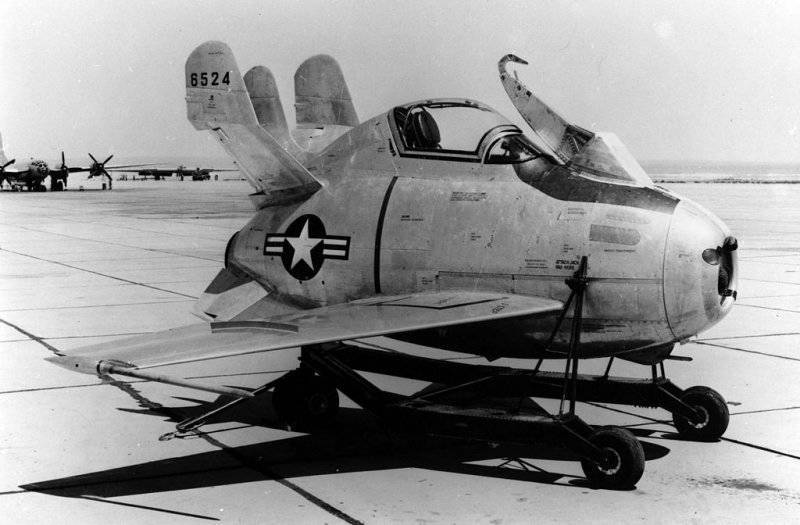
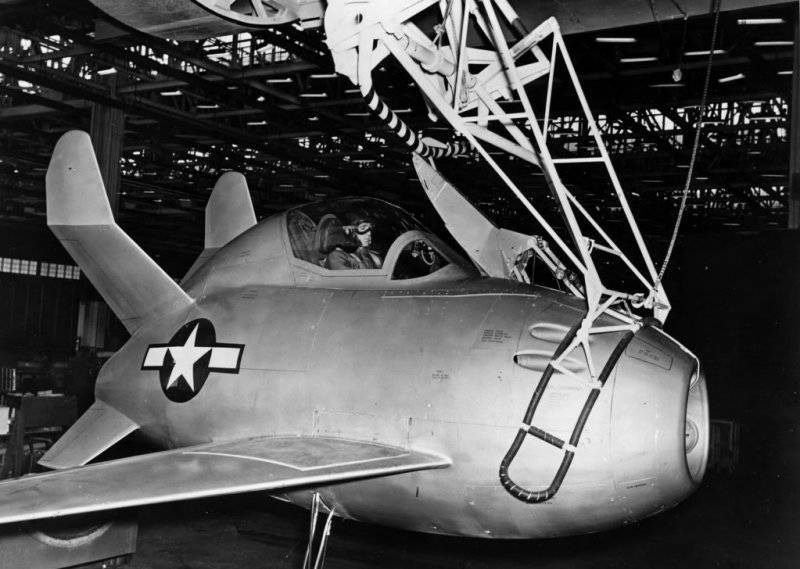
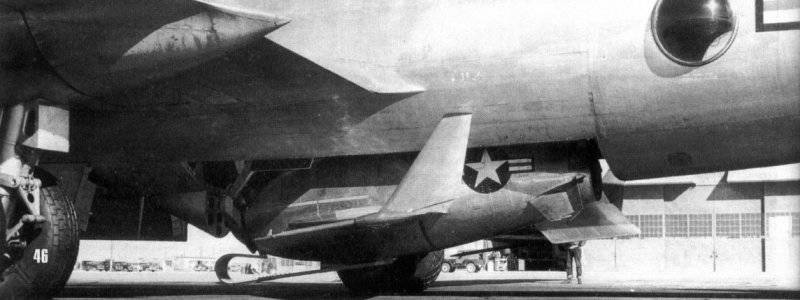
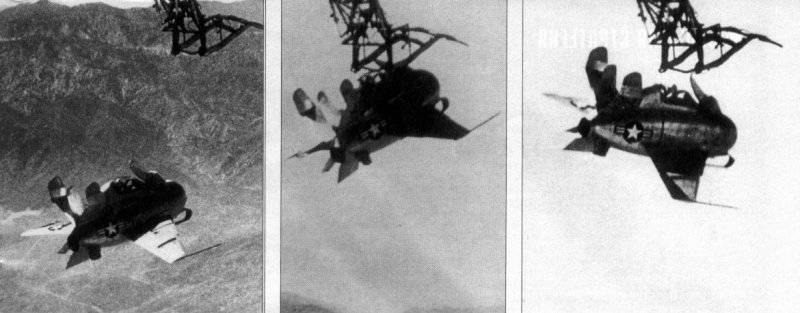
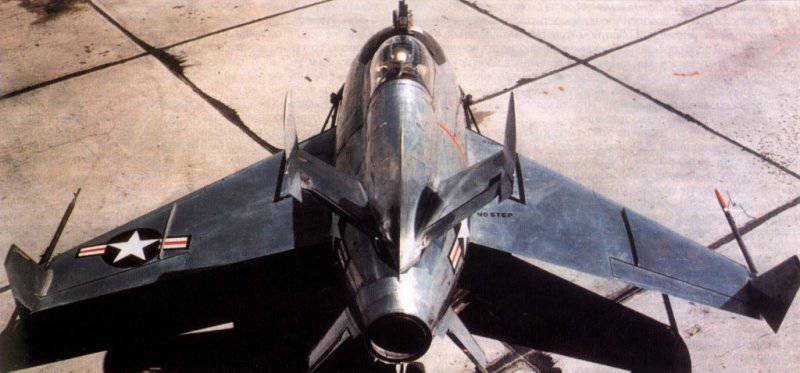
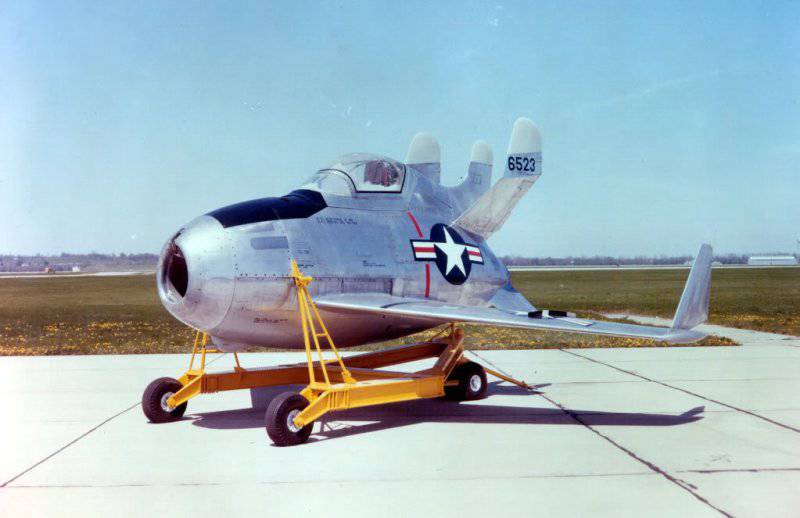
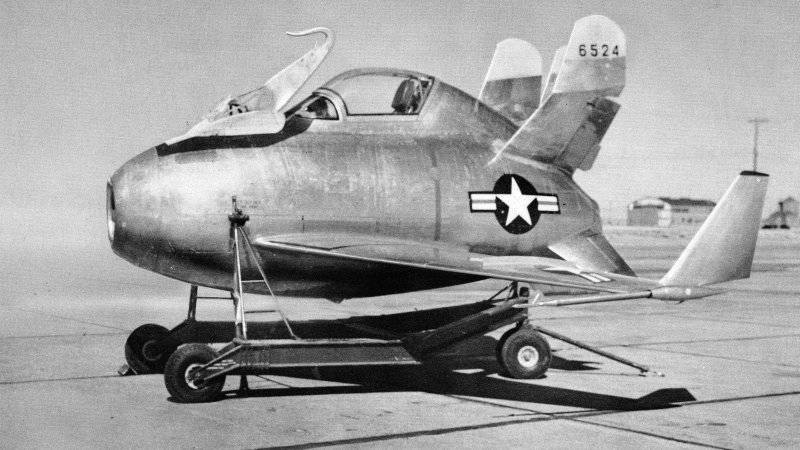
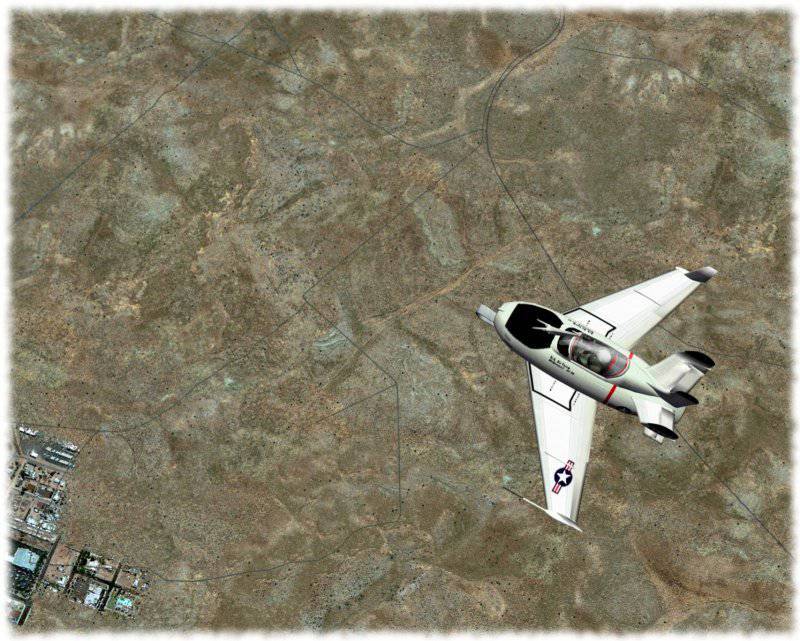
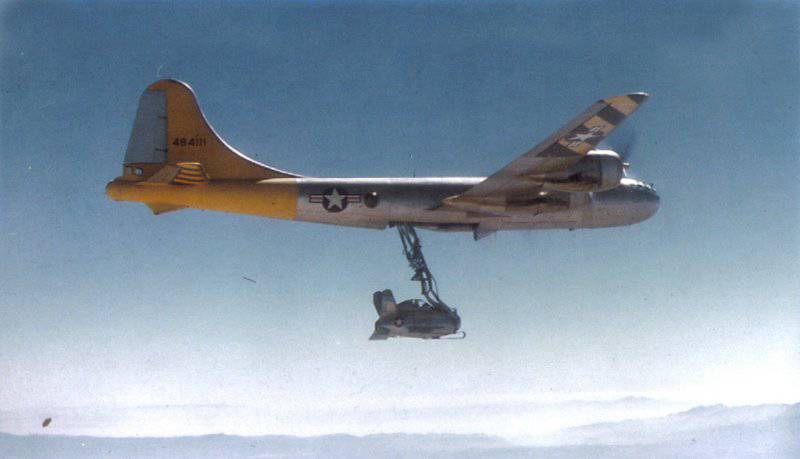
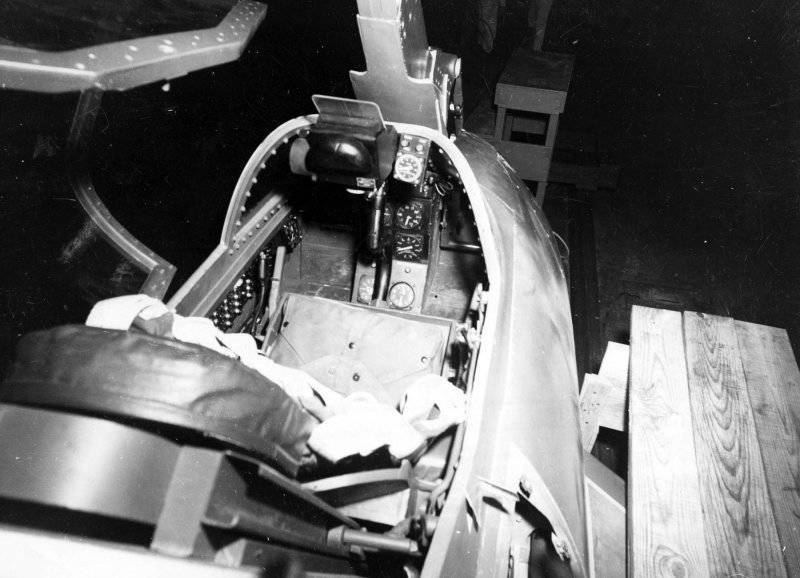
Information